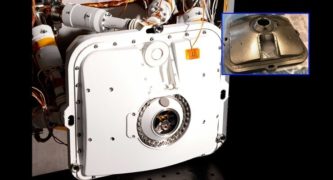
Always looking for ways to leverage new technologies to improve their spacecraft, engineers at NASA’s Jet Propulsion Laboratory have included 11 3D-printed metal parts on their Perseverance rover, set to touch down on Mars in February, according to JPL.
The burgeoning manufacturing technology presents new opportunities for space probe designers, although the application of the technique for out-of-this-world applications remains a new and developing field, JPL said in a written statement.
“Instead of forging, molding, or cutting materials, 3D printing relies on lasers to melt powder in successive layers to give shape to something,” the statement said. “Doing so allows engineers to play with unique designs and traits, such as making hardware lighter, stronger, or responsive to heat or cold.”
Andre Pate, who serves as Group Lead for Additive Manufacturing at JPL, likened the process to working with papier-mache.
“You build each feature layer by layer, and soon you have a detailed part,” he explained.
The parts made from 3D-printed metal are ones considered “secondary structures,” meaning that their failure would not jeopardize the larger mission, according to JPL.
Nonetheless, “Flying these parts to Mars is a huge milestone that opens the door a little more for additive manufacturing in the space industry,” Pate said.
The high-tech components are contained inside two instruments on the rover: Planetary Instrument for X-ray Lithochemistry, or PIXL, and the Mars Oxygen In-Situ Resource Utilization Experiment, or MOXIE.
The parts made from printed metals, such as titanium, can be made with up to four times less mass than conventionally machined parts, reducing their weight, which is a constant concern for spacecraft builders.
“In a very real sense, 3D printing made this instrument possible,” JPL’s PIXL Lead Mechanical Engineer Michael Schein said. “These techniques allowed us to achieve a low mass and high-precision pointing that could not be made with conventional fabrication.”
Perseverance is scheduled to touch down on the Red Planet on Feb. 18.
More information on the mission is available online at nasa.gov/perseverance.














 0 comments
0 comments


